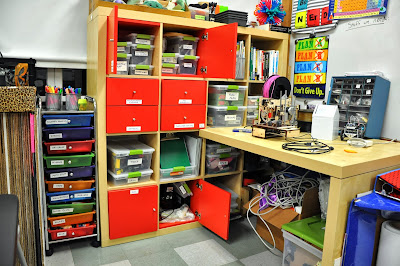Our new classroom "Makerspace" (pictured to the left) is anchored by a new piece of furniture donated by my (Ms. Mytko's) roommate. After weeks of combing local used office equipment spaces and other recycling establishments (like Urban Ore), I would have been thrilled with even a functional shelving unit. But then this - with coordinating doors, drawers, and the desk - w00t!
If someone would have told me last year that I could fit this large additional piece of furniture in my classroom, I would have laughed. To give you an idea, here is a picture (below) of the science classroom from the far back corner of the room. It is not large by any means, and space is at a premium. With 24 eighth graders in there, things can get pretty tight. But, we figured out a way to make it work.
If you look to the far right of the picture, you might also see three 4-foot tables that I rescued from various spots from around the school. After tightening some screws and lining them up, they represent our "design studio" with a couple of old laptops, our Makerbot* and our newest Printrbot*. These tables, in addition to the shelving unit required us to push the lab tables even closer together.
But the loss of space due to the additional furniture was worth it, for it made a dedicated space for all of our tools. We have a bin for MaKey MaKey*, Arduino*, Raspberry Pi* and a LilyPad*. We also have drawers designated for batteries, safety glasses, duct tape, measuring tapes, sewing supplies*, felt* and timers. We have shelves for our one set of Makedo*, books* (including my favorites!), Make Magazines*, a used Kinect scanner*, clipboards, small dry erase boards for planning, and a bunch of items from a resale shop that we hope to eventually 3D scan. We have a bin clearly marked "tools" and a designated space for the soldering iron* and glue guns. There's even a bin labeled "raw materials" which hold cardboard and other assorted scraps for spontaneous making. And, of course, the "bucket of things you can take apart."
What is most interesting to me is that, besides the electronics equipment, most of these materials are new in my classroom. What is new is their visibility and accessibility. Before, these supplies lived in a bin or in some cabinet, only to be taken out by the teacher when part of an activity in the curriculum. But now, students have been coming in on their free time and lunch periods to calibrate the Printrbot or expand on some idea they are working on with MaKey MaKey. When some kid comments, "I think the gear is stuck," another student will respond by grabbing the pliers out of the tool bin, or when some kid lost the plastic scraper for our 3D printer, another kid jumped on Thingiverse, downloaded an stl file, and printed a replacement. For the first time, students do not have to go through me to access the materials - they figure out what they need and know where to find it. And they are starting to train each other how to use the various equipment, increasing their own buy-in, and decreasing the need for teacher direction! It feels like a working space, and the kids are taking advantage of it.
Do I wish I had more space, time and resources for students to tinker and make things? Absolutely. But I knew I couldn't wait until I had the perfect space (and materials) to make that happen. Instead I had to make the space - both physical and (more importantly) perceived. I used to give all the credit to that shelving unit, but we're starting to realize that the shelf does far more than just hold the supplies, it helped shift the attitude from classroom to makerspace by keeping already existing tools visible and accessible, and empowering the kids to use them.
If you want to read more about the specifically 3D printing things we are up to, you can visit the blog I created with the kids: Tales of a 3D Printer.
UPDATE FEB 2014: The kids have really taken to our Makerspace and it is used constantly during free periods and frequently during classes. We are constantly adding to it as needs arise (ex: embroidery hoops for e-textiles, our 3Doodler, more bins, and lots and lots of cardboard and duct tape). The visibility is definitely nurturing our making adventures this school year!
 |
| Sometimes I feel like our makerspace is slowly taking over our life science classroom! |







Thank you for describing your maker space! Can't wait to get going on ours!
ReplyDeleteWhich bins are you referring to exactly? There is that rolling organizer you can get at any office store or Joanne Fabrics. The 14 colored bins are a child's "plastic toy organizer" from Target!
ReplyDelete